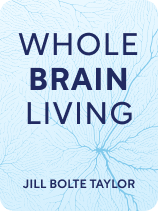

This article is an excerpt from the Shortform book guide to "Whole Brain Living" by Jill Bolte Taylor. Shortform has the world's best summaries and analyses of books you should be reading.
Like this article? Sign up for a free trial here.
What is Jill Bolte Taylor’s Whole Brain Living about? How do the different parts of our brains work together like a team?
When neuroscientist Jill Bolte Taylor suffered a stroke on the left side of her brain, her life as she knew it dissolved as she lost access to basic cognitive functions. Taylor’s key insight from her experience is that we can choose to access different parts of our brains.
Read below for an overview of Whole Brain Living and how to improve your emotional well-being.
Whole Brain Living by Jill Bolte Taylor
When neuroscientist Jill Bolte Taylor suffered a stroke on the left side of her brain, her life as she knew it dissolved as she lost access to cognitive functions such as her language skills, memories, and ability to reason. When only the right side of her brain was functioning after the stroke, she experienced a period of cosmic bliss, unburdened by her ego and past traumas. After eight years of recovery, she regained her left-brain cognitive functions and memories, and she also retained a connection to the right side of her brain that brought her profound inner peace.
Rather than returning to life as usual, Taylor wanted to share her experience and insights with the public. She first shared her experience in a 2008 TED talk, which quickly reached millions of viewers on the internet. The cultural impact of this video led her to write her memoir, My Stroke of Insight (2008), describing her experience of having a stroke, her recovery, and the lessons she learned about accessing the sense of inner calm associated with the right hemisphere of her brain. Taylor also created the foundation Jill Bolte Taylor BRAINS dedicated to educating the public about neurological health.
Taylor’s key insight from her personal journey is that we can choose to access different parts of our brain and intentionally interrupt the automatic thought processes and emotional reactions that don’t serve us. In Jill Bolte Taylor’s Whole Brain Living (2021), she explains that not only are the two hemispheres of the brain associated with different perceptions that we can tap into, but there are also two distinct “thinking” and “emotional” modules within each hemisphere.
She defines all of these modules as the “four characters within us”—each with their own way of perceiving and navigating the world. The key to emotional well-being, she says, is understanding the four characters, being open to input from each character, and deciding which character guides our thoughts and actions.
Understanding the Brain’s Anatomy
Taylor’s neuroscience background, along with her experience of having a stroke, form the foundation of her philosophy about using the four characters to achieve a more peaceful life. To start, we’ll describe the physiological basis for the four characters: the left and right hemispheres of the brain as well as the limbic (emotional) and cortical (thinking) tissue that spans both hemispheres.
The Left and Right Hemispheres
Taylor says that the left hemisphere of the brain houses our ability to organize information in a linear and ordered way. It allows us to store memories, differentiate between past, present, and future, and recognize the physical boundaries between ourselves and others as well as individual objects. According to Taylor, our left brain is the part of us that loves structure and is motivated by external factors like social acceptance and material possessions.
The right side of the brain contributes to creative skills and big-picture thinking. It processes information purely in the present moment rather than linking it to the past or future. Taylor describes the right hemisphere as our “unconscious” mind that loves unconditionally and understands our energetic connection to everyone and everything in the universe. This is the part of her brain that shaped her transcendental experience when her stroke (caused by a hemorrhage in her left hemisphere) shut down her left-brain cognitive functions.
Taylor also clarifies that we use both hemispheres simultaneously since they’re linked by the brain’s network of neurons. She says that each hemisphere simply processes information differently, giving them different strengths, and we can think of each side as constantly competing to influence what we’ll do in response to incoming information.
The Limbic System and Cerebral Cortex
Taylor says that in addition to grasping the differences between our left and right hemispheres, it’s important to understand the two types of tissue that span both halves and divide each hemisphere into two distinct “characters.” The first type is limbic tissue, which processes emotions. Limbic tissue makes up the limbic system. This is the part of our brain that evolved earlier than the cerebral cortex, and its reactions to external stimuli are automatic and rapid. For example, when someone sneaks up on you, the limbic system might react by causing you to jump and squeal. The second type of tissue, cortical tissue, is situated outside of the limbic system in the brain (like an outer layer of an onion), and cortical tissue is responsible for higher-level thinking. Taylor explains that cortical tissue makes up the cerebral cortex, which evolved more recently in humans. The cerebral cortex is at work when we’re thinking through a logic puzzle or weighing the pros and cons of a decision.
Because of the physical arrangement of these tissues (the limbic system is closer to the brain stem than the cerebral cortex) we experience emotional reactions first—before we have a chance to rationalize what’s going on. During this initial emotional reaction, the limbic system causes physiological changes such as releasing chemicals into the bloodstream or increasing our heart rate, and this physical experience of an emotion lasts for 90 seconds. Taylor says that after that, we can use our cerebral cortex to shift our thinking and override the initial reaction. Or, we can choose to re-trigger the same emotion and start the 90-second cycle over again. She refers to this phenomenon as the “90 second rule.”
The Four Characters Within Our Brain
Now that we’ve covered the brain anatomy underlying the four characters, we’re ready to introduce where each character resides and what they’re like. Taylor claims that understanding each of these characters is the first step to being able to intentionally call on each one to take control of different situations. She says that everyone has one character associated with the left-side cerebral cortex (Character 1), left-side limbic system (Character 2), right-side limbic system (Character 3), and right-side cerebral cortex (Character 4).
Each character has its own strengths and weaknesses depending on the context. Taylor emphasizes that although we may currently have one dominant character, our dominant characters are dynamic depending on the circumstances, and we also have the power to change which character dominates. The character descriptions that follow are meant to help you get to know the diverse and contradictory desires within each of us.
How Can Your Four Characters Bring Inner Peace?
Taylor writes that there’s no one right way to coordinate your four characters. She says that to achieve a peaceful life, we must listen to all four of the characters and make sure each of them feels valued. Then, when you’ve acknowledged what each of them offers in a particular circumstance, you can be intentional about which character you want to embody as you move forward. In this section, we’ll dive into some actionable advice to achieve this.
BRAIN Technique
Taylor’s main strategy for attuning yourself to your four characters is what she calls the “Brain Huddle.” This means mentally getting the four characters together to listen to their input, and then agreeing on a plan—much like an athletic team’s huddle during a game. Taylor recommends using the acronym BRAIN and breaks down each step as follows:
B—Breathe: Take some deep breaths to take control of any automatic initial responses your body may be having. Remember that after 90 seconds, the physiological response to an emotion will pass, and you’ll then have the opportunity to decide how to act next.
R—Recognize: Taylor says to recognize what character is dominating your mindset. Think about their personalities and reflect on your behavior in the moment.
A—Appreciate: Next, Taylor recommends appreciating the dominant character as well as your other characters simply for existing. Remember that each has value and importance in your life.
I—Inquire: At this point, let each character express their point of view by thinking through the scenario from the perspective of each one. Taylor says that after consideration, decide on the best course of action—ideally aiming for a peaceful resolution.
N—Navigate: The last step is navigating the outcome of your decision in the previous step. Taylor points out that regardless of your choices, you can’t control other people’s reactions, but you can respond thoughtfully. For example, if you’re in the middle of an argument with your parent, who insists on staying in a hostile and fear-driven mindset, you may need to put your most empathic, compassionate Character 4 forward to respond to their Character 2 and de-escalate the conflict.
Tips for Using the BRAIN Technique
Beyond detailing the main steps of the BRAIN technique, Taylor describes a few tips for how to use this strategy in your daily life to improve your relationships with others, improve your emotional well-being, and master the art of embodying each character when you need them.
Tip 1: Get to Know Other People’s Characters
Since everyone you interact with has their own four characters with conflicting desires and personalities, we can improve our relationships with others by increasing our awareness of their characters. For example, you might recognize that your friend embodies their joyful Character 3 when you go hiking together, but they tend to shift into their hostile Character 2 when you play competitive board games. Then, you can use these insights to maintain a positive dynamic (perhaps stick to hiking) or talk with them about negative patterns (“Why do you always flip the Monopoly board when I win?”).
Tip 2: Check in Regularly With Your Four Characters
Taylor says that like with other skills, using the BRAIN technique to your advantage takes practice. She recommends making the BRAIN strategy a habit by going through the steps regularly: for example, every morning when you wake up, nightly before bed, whenever you feel a strong emotion coursing through your body, or when you’re in the middle of an interpersonal conflict. Taylor says that when you choose a specific mental pathway enough times, it becomes the default. For instance, if you consistently and intentionally suppress your Character 1 (who makes you feel anxious when you’re trying to enjoy unstructured fun time), eventually your Character 3 will learn to automatically take over in those situations.
Another good time to assemble your four characters, Taylor says, is when your brain feels like it’s getting sucked into addictive technologies. She claims that many technologies are designed to keep us hooked and can make us more socially isolated because we’re so engrossed in them that we neglect interpersonal connections. She suggests that this may be especially true for younger generations who’ve been raised in close proximity to technologies like tablets, games, and cell phones. By using the BRAIN technique, we can choose to disconnect from technology and decide where we can best allocate our time and attention.
Tip 3: Recognize Patterns and Strategize in Advance
In addition, Taylor recommends using the BRAIN strategy as a tool to reflect on your behavioral patterns and strategize in advance for how you’ll react in a specific situation. For example, if using the BRAIN technique has taught you that your Character 1 likes to take control of vacation plans to the point that other people aren’t having fun, you can plan ahead (still satisfying a Character 1 urge) and avoid this problem by getting feedback from others about what they want to do or only scheduling activities for part of your next vacation.
Tip 4: Work Toward Recovery From Addiction
Taylor explains that when someone is addicted to drugs or alcohol, there are common patterns in how the characters’ dynamics play out. She says that in order to have long-term success in their recovery, all four characters have to participate in the process. Here are the common roles for each character and how they can cooperate in recovery:
Character 1 tends to judge themself harshly for failing to quit. To avoid letting down their loved ones because of a relapse, they’ll scheme and lie to hide their substance use. Taylor says that to heal, Character 1 needs to let go of their negative self-judgments.
Character 2 experiences distress from a whirlwind of negative emotions: They feel emotionally isolated from others, guilty about their shortcomings, angry toward others who may have played a role in their suffering, and fearful that others will stop loving them because of the addiction. Taylor claims that Character 2 has to end these cycles of guilt and resentment and focus on a brighter future.
Character 3 wants to leave their past behind and enjoy periods of sobriety with their loved ones. However, Taylor writes that this desire to reconnect with others has to be accompanied by a commitment to ongoing effort.
Character 4 is the one who reminds an addict that each day is a new opportunity to make positive changes. Taylor also claims that because Character 4 is attuned to the powerful cosmic energy that’s in everything (what she calls the “life-force of the universe”), Character 4 is also the higher power that enables spiritual healing during a lifelong recovery from addiction.

———End of Preview———
Like what you just read? Read the rest of the world's best book summary and analysis of Jill Bolte Taylor's "Whole Brain Living" at Shortform.
Here's what you'll find in our full Whole Brain Living summary:
- How you can choose to access different parts of your brain
- The four areas of the brain that perceive and navigate the world differently
- How to achieve emotional well-being by getting to know our brains better






